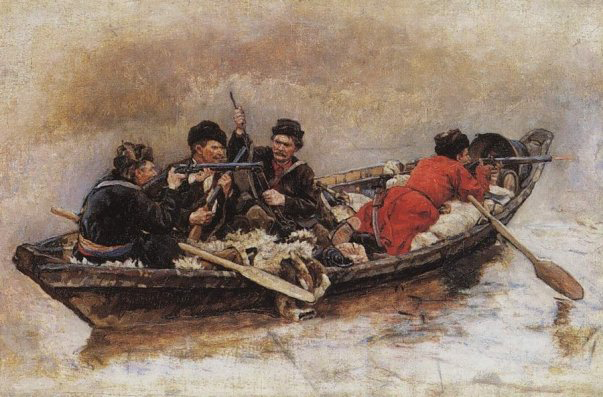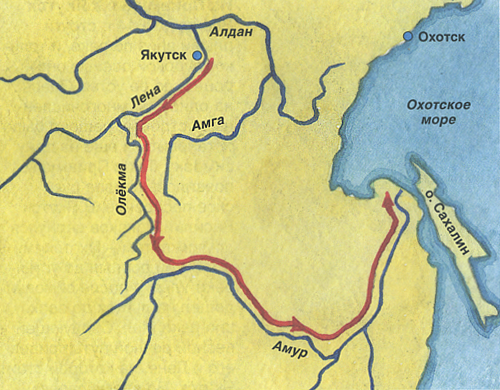(born between 1605 and 1607 - died in 1671), explorer and tiller, industrial and commercial man, explorer of Eastern Siberia, son of a boyar.
Born in the Vologda region. in a family of Pomor peasants. In the winter of 1628 he went to Mangazeya to work, in the summer of 1629 he reached Kheta through Turukhansk and the river. Pyasin. Until the spring of 1630 he served as a toll collector in the Khet winter hut. E. Khabarov returned home no later than the beginning of 1631 with a considerable "earnings". In 1632 he arrived on the Lena and until 1639, hunting for sable, visited the upper reaches of the river, walked along its tributaries - Kuta, Kirenga, Vitim, Olekma and Aldan. Having put together an artel, he exchanged the mined “soft junk” (furs) in Siberian cities for goods for the local population.
During wanderings on the bass. Lena E. Khabarov collected information about its tributaries, the peoples living there, was interested in minerals. He discovered salt springs at the mouth of the Kuta and discovered "good lands" for arable land. By the spring of 1641, the first Siberian farmer raised about 28 hectares of virgin land, built the first salt pan in Eastern Siberia, set up the sale of salt, got horses and began to transport state goods to Yakutsk.
The governor illegally took the buildings, grain reserves and income of E. Khabarov into the treasury. Then he moved to the mouth of the Kirenga (spring 1641), plowed 65 hectares and got a good crop of cereals. The governor soon appropriated this farm, and for refusing to lend money, he confiscated 48 tons of bread from him, tortured him and imprisoned him for almost two and a half years. Upon returning to Kirenga, E. Khabarov again sowed bread and built a mill.
When rumors of discoveries on the Amur reached him, he closed his business, gathered a gang of "eager people" and arrived in Ilimsk. Having received permission from the new voivode to go to the Amur, he took on credit military equipment, weapons, agricultural implements and, at the head of a group of 60 people, left Ilimsk in the spring of 1649, and in the fall he climbed on plows along the Olekma.

The detachment spent part of the winter at the mouth of the Tungir, until the beginning of March 1650 crossed to the Urka (the left tributary of the Amur), and from there headed down the Amur, meeting deserted villages and towns. In one of the villages he was told about the "luxury of the country" beyond the Amur, the ruler of which has an army with "fire fighting" and cannons. E. Khabarov left about 50 people in an abandoned town on Urka, on May 26, 1650 he returned to Yakutsk and began to spread exaggerated rumors about the wealth of the new "land".
Appointed as the "order man" of the Daurian country, he set out from Yakutsk in the first half of July with 150 volunteers and arrived in the fall on the Amur. He spent the winter in the captured town, and in June 1651, having built several boards and plows, he began rafting down the Amur past the villages burned by the inhabitants themselves.
In March 1652, E. Khabarov defeated a detachment of two thousand Manchus and moved up the Amur, making stops to collect yasak from local residents. In early August, 132 rebels fled from the mouth of the Zeya down the Amur on three ships from Khabarov's detachment, dissatisfied with constant movements. They reached the lower reaches of the river and cut down the prison.

Map-scheme of the campaign of Khabarov Yerofey Pavlovich
In September, E. Khabarov swam to the fortification, took it after the siege, flogged the “disobedient” with batogs and whips (many died from beatings). He spent his fourth winter in prison, and in the spring of 1653 he returned to the mouth of the Zeya. During the summer, his men sailed up and down the Amur collecting yasak. In August, a royal commissioner arrived from Moscow with awards to the participants in the campaign and removed E. Khabarov from leadership. When he began to object, the king's envoy beat him and in July 1654 brought him to the capital.
A year later, the tsar elevated E. Khabarov to the “children of the boyars”, gave several villages in Siberia to “feed”, but forbade him to return to the Amur. Between 1655 and 1658 E. Khabarov carried out trade transactions in Veliky Ustyug and went to the Lena. Farming and fishing allowed him to return part of the debts to the treasury. In the autumn of 1667, in Tobolsk, he informed the compilers of the “Drawing of All Siberia” information about the upper reaches of the Lena and the Amur. In January 1668 in Moscow, the explorer again asked to be released to the Amur, but was refused and returned to the Lena. Three years later he died in his settlement at the mouth of the Kirenga.
Entrepreneurial, industrious, cruel and merciless, E. Khabarov cared for the interests of the state, not forgetting his own. He considered it necessary to annex the Amur kr. to Russia. According to his information, the “Drawing of the Amur River” was compiled - the first map of the Amur Territory.
The region, the city, as well as the village and the railway station - Yerofey Pavlovich - on the Trans-Siberian Railway are named after Khabarov.
article from the encyclopedia "The Arctic is my home"
